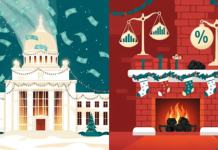As we head into the fourth week of a significant pullback in the major market averages, the investment landscape is more turbulent than ever. What started as fears of prolonged inflation and relentless interest rate hikes has now morphed into concerns about an impending recession. The narrative has shifted, and with it, investor sentiment.
The tech sector, once the darling of the market, is now leading the decline, dragging the Nasdaq 100 (QQQ) into a 10% correction. With the Magnificent 7 reporting their earnings—except for Nvidia—the market’s harsh reality is becoming evident. The growth that justified sky-high valuations just weeks ago is no longer there, and even Warren Buffett’s decision to halve his Apple stake has added fuel to the fire.
But amid this turmoil, a critical question looms: Is this a bear market or a fleeting correction? While some economic indicators flash warning signs, others suggest that this might just be another blip—a buying opportunity in disguise. In today’s edition of The Market Pulse, we’ll go into the current market dynamics, explore what lessons can be learned, and help you Be Smarter This Week with insights from our This Week I Learned section.
This Week I Learned…
Understanding Market Corrections: What You Didn’t Know
This week, let’s unpack something that’s been on everyone’s mind: market corrections. When we hear terms like “bear market” or “market correction,” they often come with a sense of impending doom. However, not all corrections lead to a bear market.
A market correction is typically defined as a decline of 10% or more in a stock index from its recent peak. It’s a natural part of the market cycle and happens on average about once a year. But here’s what you might not know: Corrections can actually be healthy for the market. They prevent bubbles by allowing stocks to retreat from overvalued levels, providing opportunities for investors to buy quality stocks at lower prices.
The current decline in the tech sector, for instance, while unsettling, could be setting the stage for future gains. Corrections help realign stock prices with their fundamental values, and while they can be painful in the short term, they often pave the way for a more sustainable rally in the long term.
So, this week, you can say, “This week I learned that market corrections, though uncomfortable, are often necessary and can present buying opportunities for those with a long-term view.”
The Fun Corner
A Bear-y Good Laugh
Why did the investor break up with the stock market?
Because it had too many bear hugs and not enough bull runs!
In this market blood bath, sometimes it’s good to take a step back and find a bit of humor in the situation. After all, the market has its ups and downs, and while a bear market can be intimidating, it’s all part of the investing journey. Remember, even the biggest market bulls need to dodge a bear or two along the way!
Is This the Bear Market They Have Been Talking About?
The major market averages, particularly the tech-heavy Nasdaq, are experiencing a notable pullback, raising the question: Are we in the early stages of a bear market? The sell-off, which began as a reaction to inflation fears and the prospect of higher interest rates, has now transitioned to concerns over a potential recession. The Federal Reserve’s actions—or inactions—are under intense scrutiny, with some investors worried that the central bank may have waited too long to pivot from its tightening stance.
In this environment, the tech sector has taken a significant hit, with the Nasdaq 100 correcting by 10%. The “Magnificent 7” tech giants, who led the market to new highs earlier this year, are now dragging it down. Investor sentiment has soured, particularly after Warren Buffett’s Berkshire Hathaway reduced its stake in Apple, signaling a shift in confidence.
But is this truly the onset of a bear market? Historically, bear markets are characterized by declines of 20% or more, often driven by deteriorating economic conditions. While the economy shows signs of slowing, with job gains moderating and concerns about a recession on the rise, the overall economic data suggests that we may be in a mid-cycle slowdown rather than a full-blown recession.
Market corrections, like the one we’re witnessing, are part of the natural market cycle. They often shake out weaker hands and set the stage for the next leg up. The current pullback could be a buying opportunity, especially if the Fed signals a shift in policy that reassures markets.
For now, it’s crucial to stay vigilant, assess your portfolio, and consider whether this downturn offers opportunities to pick up quality assets at a discount. After all, in every market cycle, there are moments that define long-term performance. This could be one of them.
The Last Say
Is It Really a Bear, or Just a Growl?
As we wrap up this edition of The Market Pulse, we find ourselves at a pivotal juncture. The market is sending mixed signals—technology stocks are in correction territory, recession fears are mounting, and yet, opportunities still abound. Whether this is the start of a bear market or just a temporary setback is up for debate, but one thing is clear: Investor sentiment is fragile.
This week, we’ve explored the intricacies of market corrections, understanding that they are not only common but also necessary for a healthy market. We’ve seen how the tech sector, once untouchable, is now leading the decline, reminding us of the cyclical nature of the market.
As we look ahead, the key will be watching the Fed’s next moves and how the broader economy reacts. The possibility of rate cuts could either rejuvenate the market or confirm the recession fears that have been looming for months. Either way, staying informed and prepared will be your best strategy in navigating these uncertain times.
Stay tuned for the next edition of The Market Pulse where we’ll continue to dissect market trends and provide you with the insights needed to stay ahead in this volatile environment. Until then, keep a close eye on the data, and remember, whether it’s a bear market or just a growl, informed decisions are your best defense.

























